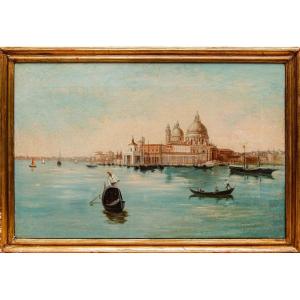View of Venice with Punta della Dogana and Santa Maria della Salute
Oil on canvas, cm 41 x 61
With frame, cm 47,5 x 67
The painting in question, characteristic of the vedutist movement that developed during the nineteenth century in Italy and abroad, depicts a view of Venice, with particular attention to Punta della Dogana and the Basilica of Santa Maria della Salute. The work captures the unique atmosphere of the lagoon city, with its sparkling waters, gondolas that cram the canals and buildings that are reflected on the water. The term Vedutismo derived precisely from the main subject represented, the so-called views, that is suggestive panoramas imprinted on canvas by the great painters of the time. They differed from the previous landscape paintings precisely because of their strongly realistic nature, their almost maniacal attention to detail and the total preponderance of the landscape element: before the vedutismo, In fact, the landscapes were almost exclusively used as panoramas, that is, as a backdrop for the representation of men, women or animals, who remained at the centre of the scene. This new artistic trend brought the landscape to take the role of protagonist of the work. The reasons for this success are to be found in the custom of the Grand Tour, the journey made by young sons of the European nobility to discover the continent, which had as its favorite destination Italy: Florence, Rome, Naples and obviously Venice, the most fashionable city of the whole eighteenth century, where the English were delighted by the "decadent Italian charm". The main supporters of vedutism used to use the optical camera, a very valuable tool that allowed to represent reality in lenticular way.








































 Le Magazine de PROANTIC
Le Magazine de PROANTIC TRÉSORS Magazine
TRÉSORS Magazine Rivista Artiquariato
Rivista Artiquariato